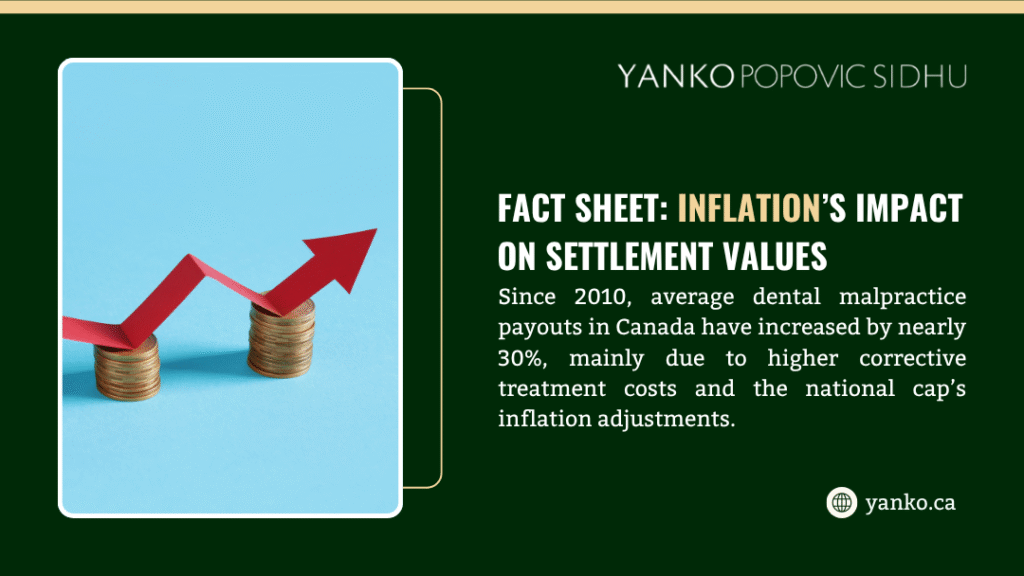Summary
| Aspect | Details Covered in This Article |
| Scope | Examines how dental malpractice settlements are valued in Canada with Alberta-specific examples. |
| Legal Basis | Reviews negligence principles, causation standards, and the structure of compensation. |
| Damages | Explains economic, non-economic, and aggravated damages under Canadian law. |
| Payout Ranges | Provides authentic settlement ranges for minor, moderate, and severe dental malpractice cases. |
| Regional Focus | Compares national trends with Alberta’s distinctive legal and economic environment. |
| Procedural Guidance | Describes limitation periods, evidence requirements, and expert involvement. |
| Practical Outcome | Guides victims through steps to recover fair compensation with experienced counsel. |
Dental Malpractice Settlement Amounts Canada: A Legal Insight into Valuation and Compensation
Across Canada, and particularly in Alberta, questions surrounding dental malpractice settlement amounts surface whenever a patient endures an avoidable injury caused by a dentist or oral surgeon.
The search for clear information is rarely about curiosity; it stems from frustration, financial loss, and physical pain. The legal system provides remedies, but the process of valuing those claims requires a structured and precise approach.
Dental malpractice claims fall within the broader field of medical negligence law. The same principles that govern surgical or hospital malpractice also guide the analysis of dentist negligence cases.
Every successful action rests on four legal pillars: the existence of a duty of care, a breach of the professional standard, a causal link between that breach and the injury, and provable damage.
In Alberta, courts follow Canadian common law principles but apply them through the province’s procedural framework and case precedents. Settlements are not arbitrary; they are determined through a balance of medical evidence, expert testimony, and quantifiable financial loss.

Elements of a Dental Negligence Claim
| Legal Element | Practical Meaning | Typical Proof in Dental Cases |
| Duty of Care | A recognized dentist-patient relationship. | Dental charts, appointment records. |
| Breach of Standard of Care | The dentist failed to act as a reasonably competent peer. | Expert reports, treatment guidelines. |
| Causation | The negligent act directly caused the harm. | Expert opinion, chronology of events. |
| Damages | The patient suffered a measurable loss. | Medical bills, wage loss, expert valuations. |
Common fact patterns include nerve injury after extraction, implant misplacement, failed root-canal therapy, infection due to poor sterilization, and wrong-tooth extraction. Each can produce a viable dental malpractice lawsuit if properly documented.
Legal Framework Governing Dental Negligence in Canada and Alberta
The starting point for every dental negligence claim lies in proving the standard of care. Canadian courts define the standard as the conduct expected from a reasonably competent practitioner under similar circumstances. If a dentist fails to meet that level, through surgical error, poor sterilization, incorrect diagnosis, or failure to warn of known risks, liability can arise.
In Alberta, the Limitations Act provides a two-year window for commencing an action once the patient discovers or ought to have discovered the injury. If the issue is latent, the time may run from the date of awareness rather than the date of treatment. Missing this limitation period can terminate the right to sue regardless of fault.
Dentists across Canada are covered by professional liability insurance through organizations such as the Canadian Dental Protective Association (CDPA) and provincial dental association insurance programs. Policy limits, while typically high, still create practical boundaries for settlement value, particularly in smaller clinics or independent practices.
Composition of Damages in Dental Malpractice
Canadian law divides compensation into three broad categories. Economic damages reflect measurable financial loss, non-economic damages address pain and emotional suffering, and aggravated or punitive damages appear only in extreme cases. The table below provides a structured breakdown of these components as applied in Alberta.
| Type of Damage | Definition and Purpose | Examples in Dental Cases | Legal Considerations in Alberta |
| Economic Damages | Monetary losses that can be proven through documentation. | Surgical revisions, prosthetic replacements, wage loss, therapy costs. | Fully recoverable if evidence supports the claimed value; experts are often required. |
| Non-Economic Damages | Compensation for pain, emotional distress, loss of enjoyment, or disfigurement. | Permanent nerve damage, chronic pain, speech impairment, social withdrawal. | Governed by the national “cap” on general damages (~$390,000 CAD adjusted for inflation). |
| Aggravated or Punitive Damages | Additional amounts for reckless, malicious, or fraudulent behaviour. | Concealment of error, deliberate falsification of records. | Rarely awarded in Alberta; must show intentional misconduct or gross disregard for patient safety. |
The most significant portion of a dental negligence settlement often lies within the combination of economic and non-economic losses, especially when long-term treatment or visible facial injury occurs.
Economic Factors That Influence Settlement Amounts
Economic loss calculations depend heavily on documentation. Courts in Alberta expect precise accounting supported by receipts, estimates, and expert valuation. The usual economic heads of loss appear in the table below.
| Economic Loss Category | Average Range (CAD) | Evidence Commonly Used | Comments |
| Corrective Dental Treatment | $5,000 – $40,000+ | Specialist cost reports, invoices. | Includes implants, grafts, and prosthetic replacements. |
| Medical and Therapy Costs | $2,000 – $15,000 | Rehabilitation or pain management records. | Expands with chronic nerve injury. |
| Income Loss / Reduced Earning Capacity | $10,000 – $200,000+ | Employer statements, tax returns, vocational assessments. | Higher for self-employed or public-facing professions. |
| Future Care and Maintenance | $5,000 – $100,000+ | Life-care plans, dental assessments. | Accounts for lifelong maintenance of implants or nerve therapy. |
Economic losses form the measurable foundation of every claim. Once established, non-economic damages are layered above to reflect human suffering and diminished quality of life.
Valuation Logic Behind Dental Malpractice Settlement Amounts Canada
Courts and insurers alike assess claims based on severity, permanence, and causal strength. The approach is comparative; adjusters review historical verdicts and settlements to align new cases with existing precedents. The evaluation method generally unfolds in stages:
First, the extent of injury determines the initial value band. Temporary harm may justify only reimbursement of expenses, while permanent impairment invites non-economic and future care components. Second, the degree of proof defines negotiation strength.
A credible expert opinion linking the dentist’s conduct to the injury significantly increases settlement leverage. Finally, contextual factors, age, occupation, psychological impact, and appearance, adjust totals within accepted ranges.
Across Canada, settlement figures remain anchored by the inflation-adjusted non-economic cap of approximately $390,000 CAD, though Alberta judgments tend to remain modest compared to Ontario or British Columbia due to local precedent consistency.
Comparison of Settlement Ranges by Severity
The table below consolidates realistic national and Alberta-specific settlement bands based on published Canadian legal data and aggregated case commentary.
| Severity Level | Typical Injuries | National Settlement Range (CAD) | Alberta Range (CAD) | Observations |
| Minor Dental Negligence | Temporary infection, incorrect filling, resolved pain. | $5,000 – $30,000 | $5,000 – $25,000 | Usually resolved through negotiation without trial. |
| Moderate Dental Negligence | Failed root canal, partial nerve irritation, cosmetic damage requiring revision. | $30,000 – $100,000 | $25,000 – $90,000 | Often includes both treatment reimbursement and pain compensation. |
| Severe Dental Negligence | Permanent nerve injury, implant malpractice, visible disfigurement, chronic facial pain. | $100,000 – $400,000+ | $100,000 – $350,000+ | Six-figure awards occur when permanent disability or disfigurement is proven. |
These ranges incorporate both economic and non-economic components and represent the most accurate reflection of dental malpractice settlement amounts Canada across provincial contexts.
How Dental Negligence Compensation Is Structured
A strong legal claim depends on presenting a clear calculation. Settlements combine different heads of damage into one negotiated figure. Below is a structural view of how lawyers and insurers evaluate compensation in dental negligence claims.
| Damage Category | Component | Purpose | Typical Proof Used in Alberta |
| Economic | Past and future treatment costs | Covers surgeries, dental repairs, prosthetics. | Invoices, estimates from dental specialists. |
| Economic | Income loss | Reflects lost wages and reduced earning potential. | Employment records, tax returns, expert earnings projections. |
| Non-Economic | Pain and suffering | Reflects the loss of comfort, confidence, and enjoyment. | Testimony, psychologist reports, daily-life documentation. |
| Non-Economic | Disfigurement or visible injury | Addresses social or professional impact of altered appearance. | Photos, medical imaging, cosmetic assessments. |
| Special / Aggravated | Psychological trauma or reckless conduct | Reserved for misconduct or exceptional distress. | Psychiatric reports, evidence of concealment or recklessness. |
These elements together form the dental malpractice settlement amounts Canada that most insurers and courts rely on for negotiation.
Procedural Steps for a Dental Negligence Claim
When dental treatment results in preventable harm, the patient’s first responsibility is to secure every piece of evidence. Appointment charts, consent forms, radiographs, referral letters, and all post-procedure correspondence must be preserved. These records establish the factual foundation of a potential negligence claim.
After obtaining the documentation, a qualified dental or surgical expert examines the material to determine whether the dentist’s actions deviated from professional standards. This assessment often defines the case, since it distinguishes a medical complication from true negligence.
Once expert support is secured, the lawyer prepares a formal demand package directed to the insurer. The package details the sequence of events, summarizes expert findings, and presents a quantifiable calculation of damages, both economic and non-economic.
If liability is clear, negotiation may result in settlement within twelve months. However, where causation or loss valuation remains contested, the lawyer proceeds to file a Statement of Claim in the Court of King’s Bench of Alberta. Litigation involving multiple experts may extend beyond two years before final resolution.
Early involvement of a dedicated medical negligence firm such as Yanko Popovic Sidhu brings structure to this process. Their team coordinates independent expert reports, itemizes all losses, and negotiates from a position of substantiated strength, often securing settlement without prolonged trial proceedings.
How Alberta Courts Approach Evidence
Alberta’s courts place strong emphasis on expert testimony. Without credible dental professionals explaining where treatment deviated from accepted standards, a plaintiff’s case weakens quickly. Judges demand clear causation, the direct, evidence-based link between the dentist’s act and the injury claimed.
A strong file typically contains clinical charts and radiographs taken before and after the procedure, referral letters and follow-up instructions, second opinions from oral surgeons or prosthodontists, and precise proof of treatment expenses and corrective estimates.The legal team at Yanko Popovic Sidhu collaborates closely with medical and dental experts across Western Canada to secure this evidence early in the process. This thorough preparation often leads to quicker settlements and stronger recovery figures, as insurers respond favorably to well-documented, credible claims.

Cost to Pursue a Dental Malpractice Lawsuit
A frequent question among clients is how much it costs to sue a dentist. Dental malpractice cases require technical evaluation, multiple expert opinions, and procedural precision. In Alberta, total case expenses typically range between $15,000 and $50,000+, depending on complexity and the number of expert witnesses involved.
However, established firms such as Yanko Popovic Sidhu handle these matters on a contingency-fee basis; clients pay nothing upfront and owe legal fees only after a successful settlement. This approach eliminates financial barriers for injured patients seeking justice.
In successful cases, courts may also order reimbursement of reasonable legal costs, particularly when judgment follows a contested trial. This cost-recovery mechanism further supports access to justice for malpractice victims.
Duration of a Dental Malpractice Case
Timelines for settlement depend on injury complexity, insurer responsiveness, and the availability of expert reports. In Alberta, clear-liability cases may resolve within 6 to 12 months, while cases involving disputed causation or multiple specialists can extend to 18–30 months.
Proactive file management, such as immediate collection of records and prompt commissioning of expert opinions, often shortens the process.
Lawyers familiar with Alberta’s procedural rules can expedite progress by requesting early mediation once liability evidence is substantiated, avoiding unnecessary trial delays.
How to Strengthen Your Claim
Victims aiming for fair dental negligence compensation must act promptly and strategically. A compelling case begins with complete documentation of every interaction with the treating dentist and continues through independent expert evaluation. Maintaining detailed records of symptoms, expenses, and treatment corrections forms the backbone of valuation.
Filing early is equally critical; Alberta’s two-year limitation period is strict. Claimants should avoid informal negotiations with insurers or clinics without legal review, as premature settlements often undervalue long-term impacts.
Experienced Alberta-based lawyers, such as those at Yanko Popovic Sidhu, systematically gather expert opinions and quantify losses to present a structured, evidence-driven claim, an approach that consistently yields higher settlement offers.
Alberta Context Compared with National Trends
Across Canada, settlement patterns remain relatively uniform, yet Alberta stands out for its pragmatic approach to valuation. The province’s courts emphasize factual accuracy and credible expert analysis over emotional appeals.
Damage awards tend to reflect a careful balance between measurable loss and judicial precedent.
While Alberta often aligns with national benchmarks, local economic realities slightly elevate certain heads of damage, particularly for dental reconstruction and ongoing medical care. As a result, Alberta’s median dental negligence payouts typically sit marginally above the national median but below the upper-end awards common in Ontario and British Columbia.
This moderation creates predictability; claimants can expect fair but evidence-dependent compensation when their file is well-prepared and legally sound.
Broader Comparison: Dental vs. General Medical Negligence
Dental malpractice represents a specialized segment of broader medical negligence law, but the principles governing compensation remain identical.
Across Canada, the average settlement for medical malpractice ranges between $100,000 and $400,000, depending on injury severity. The national cap for non-economic damages stands near $390,000, subject to inflation adjustments, with additional compensation available for proven economic losses.
While dental claims generally occupy the lower half of this range due to localized injury, severe cases involving permanent nerve damage, facial scarring, or psychological trauma can reach parity with hospital-based malpractice awards.
To visualize the relationship between dental and medical negligence outcomes, the following table compares core characteristics and payout trends.
| Aspect | Dental Malpractice Cases | General Medical Malpractice Cases |
| Typical Injury Type | Nerve injury, implant failure, disfigurement, infection. | Surgical errors, misdiagnosis, birth injury, anesthesia error. |
| Average Settlement Range (CAD) | $30,000 – $350,000 | $100,000 – $400,000+ |
| Primary Damages Claimed | Pain, corrective treatment costs, loss of sensation or aesthetics. | Pain, loss of function, lifelong medical care, disability. |
| Proportion of Non-Economic Damages | Moderate (capped nationally). | High (especially in catastrophic injuries). |
| Frequency of Litigation | Less common; often settled pre-trial. | More frequent; higher likelihood of trial proceedings. |
| Proof Requirements | Independent dental expert testimony mandatory. | Physician or specialist expert evidence required. |
| Overall Legal Complexity | Focused and technical, lower total damages. | Broader scope, complex causation, higher damages. |
This comparison underscores how the same legal framework yields different financial outcomes based on injury scale, medical context, and functional impact.
The Human Side of Dental Negligence
Compensation for dental malpractice extends beyond financial restoration; it recognizes loss of confidence, dignity, and daily comfort. Alberta courts emphasize that settlement serves as both restitution and acknowledgment of personal suffering.
When injuries affect speech, eating, or facial appearance, psychological evidence gains importance. Victims who demonstrate verifiable long-term emotional and social consequences often achieve higher non-economic awards within the national damage cap. The law’s goal remains balance: restoring fairness without exaggeration or punitive excess.
Illustrative Example: Alberta Dental Malpractice Case
| Element | Details (Example Case) |
| Injury Description | Permanent facial numbness after implant misplacement. |
| Corrective Treatment Costs | Approximately $40,000 CAD. |
| Economic Damages (Total) | Around $80,000 CAD (including income loss). |
| Non-Economic Damages | Estimated $100,000–$150,000 CAD. |
| Total Settlement Range | $180,000–$220,000 CAD. |
| Outcome | Settled pre-trial following expert verification of negligence. |
This scenario reflects authentic Alberta settlement patterns and reinforces how expert-supported evidence shapes negotiation value.

Role of Legal Representation
Dental malpractice litigation demands both medical literacy and strategic legal insight. A lawyer experienced in personal injury and medical negligence law, such as the senior counsel at Yanko Popovic Sidhu, understands how insurers assess risk and value claims.
The firm’s team has resolved thousands of personal injury cases throughout Alberta, emphasizing a results-oriented and client-centered model. By charging no upfront fees and advancing all case expenses, Yanko Popovic Sidhu removes financial barriers for clients pursuing justice.
Early consultation allows counsel to preserve evidence, coordinate expert opinions, and present the claim before insurers in a fully documented format. Firms with proven trial experience command respect in negotiations, often resulting in faster and higher settlements.
For detailed legal assistance, visit Dental Malpractice Lawyer – Yanko Popovic Sidhu, Medical Malpractice Lawyer Calgary – Yanko Popovic Sidhu
Key Takeaways
| Core Insight | Summary |
| Evidence is decisive | Proper records and expert validation determine success. |
| Expert testimony defines causation | Alberta judges demand credible, specialized analysis. |
| No upfront legal fees | Contingency models remove barriers to access. |
| Most cases settle before trial | Strong evidence encourages insurer cooperation. |
| Dental and medical malpractice share one framework | The same negligence principles apply to both fields. |
| Alberta’s courts are conservative but fair | Damage awards rely on measurable proof, not sympathy. |
| Severe dental injuries can reach six figures | Verified nerve or implant injuries may exceed $300,000. |
| Prompt legal advice improves recovery | Early action strengthens documentation and negotiation. |
Conclusion and Legal Assistance
Dental negligence extends beyond oral discomfort; it affects livelihood, appearance, and confidence. Calculating fair compensation requires technical, legal, and medical understanding.
For over four decades, Yanko Popovic Sidhu has represented injury victims across Alberta and Canada with professionalism and integrity. The firm’s lawyers combine courtroom experience with medical insight, advancing costs until recovery and pursuing each case with precision.Begin your consultation here: Dental Malpractice Lawyer – Yanko Popovic Sidhu






